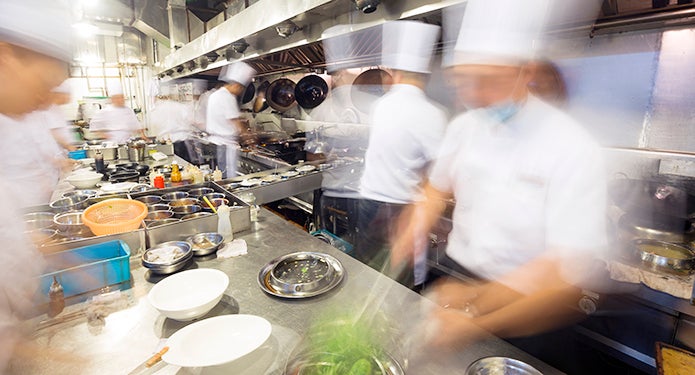If you execute an all-day dining menu with these four culinary tactics, you’re more likely to succeed … and profit.
A growing number of establishments are capitalizing on the all-day dining movement. Why? It comes down to profits. They’re breaking away from the traditional breakfast, lunch and dinner dayparts to maximize revenue within their existing footprint.
While there’s no one-size-fits-all approach for an all-day dining concept, there are some culinary commonalities among operations prospering from it. If you’re contemplating the concept, consider this your checklist for success.
Commonality #1: Chef-driven menus
In general, the offerings we’re seeing are pretty innovative, particularly at breakfast. Chefs realize that to build a successful breakfast daypart they have to serve dishes that are unique for their market—which is why the best examples of new breakfast menus have a strong chef-driven bent. The Early Bird, a cafe in London, Ontario, serves a I Feel Waffle, a house made vanilla fried waffle with cinnamon and maple poached apples, topped with roasted coffee whipped cream. Chambar, in Crosstown, Vancouver, menus a tajine amongst their breakfast offerings, which combines spicy merquez sausage, saffron tomato stew, fried pita, raita, poached egg and fresh herbs.
Commonality #2: Creative cross-utilization of ingredients
Executing an all-day menu requires creativity and diligence to ensure the number of ingredients in inventory does not significantly increase in order to produce a wider number of menu offerings. “Chefs have to be able to use ingredients across all dayparts if they are going to make this work. One ingredient with a single purpose will not keep profits in their pockets,” explains Jason Kalinowski, Gordon Food Service Customer Solutions Specialist based in Milton, Ontario. This will not only help lower your food costs and minimize your waste, but it will also lead to a chef-driven menu that will help you achieve differentiation. “Restaurants are looking at ways to stand out in the crowd by having a point of difference compared to the rest of the competition,” Kalinowski adds.
Royal Dinette in Vancouver (which was awarded “Best New Restaurant” in 2016 by Vancouver Magazine) showcases lemon balm in its Smoked Spring Salmon at lunch, which is paired with kohlrabi, fennel and salmon roe, then reappears in its Spiced Chickpea Tortellini alongside summer squash and preserved lemon.
Commonality #3: Innovative toast program
Because there is a strong connection between breakfast and lunch, nearly all of the restaurants we reviewed offered a unique selection of toasts and grilled breads. The trend in artisanal toasts started in the breakfast daypart and has expanded as chefs are offering toasts as unique open-faced sandwiches at lunch and cut into small pieces and served as sharing plates in the dinner daypart.
Nightingale in Vancouver brings this point home with four focaccia and grilled bread options, ranging from heirloom tomato salad, cucumber, roasted eggplant and pistachio salsa verde on focaccia to shaved bison tongue, apricot preserve and thyme on grilled bread. Royal Dinette serves a combination of tomato, grilled plum, ricotta and English pea vinaigrette on sourdough, and burrata, berries, rhubarb and nasturtium on grilled bread.
Commonality #4: Everyone puts a personal touch on all-day dining
There is no boilerplate formula for all-day dining. By evaluating individual capabilities, restaurants can hone in on what works best in their market and with their customers. For example, the menu size can vary. Not counting their à la carte items or sides, the brunch menu at Mildred’s Temple Kitchen in Toronto is a condensed 11 items, including a weekly brunch special. Compare that to Medina Cafe in Vancouver, whose brunch menu is 17 items—ranging from granola to cassoulet to avocado toast.
Speaking of brunch, dayparts are also handled a little differently. The purpose of all-day dining is to offer customers access to more of your menu throughout the day, but how that comes to life should be based on what works best for your restaurant. Look for inspiration among this six-restaurant comparison and then think through which daypart menu mix could work for you.
- The Early Bird: Breakfast, salads, perogies, sandwiches and poutines are available all day, plus they offer a very chef-driven blackboard menu.
- Mildred’s Temple Kitchen: They serve what they call B’lunch Monday through Friday from 11 a.m. – 3 p.m. and offer up a separate brunch on the weekends. Dinner is served Thursday through Saturday from 6 p.m. – 10 p.m.
- Medina Cafe: Their locally sourced, all-day menu is combo of brunch, sides and top-your-own waffles.
- Royal Dinette: They start with a condensed lunch menu and repeat many of those items on a slightly expanded dinner menu.
- Chambar: A selection of breakfast items are available all day, with some of those dishes repeating on their brunch menu. Lunch is mostly its own affair and the dinner menu is also unique, with the exception being the same mussel dishes from lunch.
- Nightingale: They organize their all-day menu by sections, noted as raw, vegetables, pizza, small, large and dessert.
Ultimately, all-day dining success comes down to getting your menu right and customizing the concept. If you take the time to create offerings that creatively cross-utilize ingredients, you’ll be well on your way to pleasing consumers and improving your profitability.

























